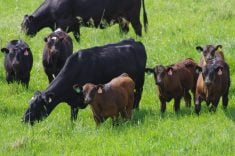The latest round of proposed changes to agricultural Crown lands has earned a tentative thumbs up from pasture and forage leaseholders.
Leaseholders “were surprised by the changes proposed by the minister,” said Brent Benson, president of the Manitoba Crown Land Leaseholders Association. “After three years of obfuscation and defiance by previous ministers, it was refreshing to be understood by Minister (Derek) Johnson.”
Why it matters: Crown land changes have been an ongoing saga in Manitoba since 2018 and came to a boiling point in 2019.
Read Also

Finally getting paid for sustainable farming?
Alberta project says they might have a line on a workable ecosystem credit model to reward farmers for sustainability, and Manitoba might be next
Manitoba’s agricultural Crown lands are parcels of public land that the government leases for grazing, haying or annual cropping. Most are used by cattle operations.
In early June, the province released the latest list of proposed regulatory changes to its modernized Crown lands system.
According to a news release, the proposed changes include:
- Determining forage capacity at the outset of a forage lease or renewable permit;
- Reducing forage lease rents over the next several years (linked to impacts from recent drought and flood seasons);
- Extending lease terms by five years (from 15 years to 20) when producers invest in forage productivity improvements;
- Enabling 15-year leaseholders to transfer the remaining years of their lease to an eligible third party;
- Developing a process that could allow legacy leaseholders to transfer their lease to a third party by nominating the next leaseholder (assuming the parcels isn’t selected under Treaty Land Entitlement and doesn’t impact Indigenous land rights);
- Adding non-profit Indigenous organizations to lease eligibility, additional to already eligible bands; and
- Formalizing the process for assessing land productivity used to determine rent, which the government says will create incentive to properly manage and invest in land.
The rent reductions were announced in 2022 and amount to a 50 per cent drop this year, 33 per cent in 2024 and 15 per cent in 2025.
Forage capacity is measured in AUM, or animal unit months, the standardized amount of forage it takes to feed an animal for a month.
Producers and the public now have 45 days to give feedback. The consultation period ends July 17.
“We encourage all leaseholders to comment on the proposed regulations and take the opportunity to make their voices heard,” said Benson. “We don’t get many chances like this.”

Diving into details
Eligible third parties include a Canadian citizen or permanent resident; a partnership made up of Canadian citizens or permanent residents; a First Nations band; a forage co-operative made up of Canadian citizens or permanent residents; a Hutterite colony or colony-owned corporation or a corporation made up of Canadian citizens or permanent residents.
The proposed amendment would increase the eligibility to include any non-profit organization that represents the interests of one or more Indigenous bands, individuals of Métis descent or other holders of Indigenous or treaty rights.
Leaseholder improvements, which would open the door for a lease extension, require that a forage management plan be implemented for at least the last five years of the 15-year lease term. These plans cover recognized practices for sustainable forage management and improved productivity.
The plan must be developed and approved by a professional agrologist. The costs associated with that plan development would be the responsibility of the leaseholder.
While plans are not mandatory, the lease cannot extend past 15 years without one, according to the proposed rule.
History
The province revamped Crown land regulations in late 2017. Then-agriculture minister Ralph Eichler announced plans to modernize the system, saying they would make the process more transparent for farmers and ranchers.

Lack of transparency was a complaint the industry had previously lodged about the former points system, which allocated leases based on a weighted scale that considered an applicant’s circumstances and other factors.
When the province announced it was replacing it with an auction system, organizations like the Manitoba Beef Producers welcomed the news. However, the flavour eventually turned sour and the file became fraught with controversy and challenges.
In 2019, a year after enshrining the auction system in legislation, the province unveiled the regulations. Rents would be set at market-based rates. Lease terms were set at 15 years, and the ability to transfer a lease (unit transfers) with the sale of private property was eliminated, although initial regulations promised a transitional transfer for existing leaseholders.
Producers were not happy.
Immediate concerns were raised over lease lengths. In places like the Interlake, where ranches might owe most of their land base to Crown land, producers said the regulation jeopardized the viability of their business by putting it on the auction block every 15 years.
The province later instituted a right of renewal for existing or ‘legacy’ leaseholders to address those concerns.

Another main irritant was elimination of the unit transfer. Producers with most of their land base tied up in leases said their ranches were unsellable without the ability to tie lease rights to the sale of their private property. The province argued that unit transfers artificially inflated ranch values and that nowhere else could a farmer expect to transfer rights to land they rented if they sold their farm.
The issue was further inflamed when the province eliminated a one-time transitionary unit transfer that was promised to producers.
The file has gone through an election, two premiers, three agriculture ministers and a long list of criticism from leaseholders and the opposition NDP.
The party’s ag critic has repeatedly brought up the Crown land issue in the Legislature, and party leader Wab Kinew has said the NDP would re-establish unit transfers.
“In the last election, Brian Pallister didn’t tell anyone about his plan to increase rent on Crown land leaseholders or undermine their businesses by cutting unit transfers,” Kinew said in an emailed statement to the Co-operator.
“He hid his plan from producers until after the election and ignored them when they raised concerns.”
Kinew said this latest proposal is linked to the upcoming provincial election.
Premier Heather Stefanson “kept Pallister’s system and continued to ignore producers, but now, months before an election, she’s scrambling.”
Producer feedback
In late 2022, the province launched a survey to take the public and industry pulse on Crown lands.
In those results, released earlier this year, 85 per cent of respondents said they wanted the return of unit transfers.

Benson noted the proposed ability to transfer rights for the remainder of a lease, as well as the legacy leaseholder potential to nominate successors.
“While not the ideal solution we have been lobbying for ever since the disastrous changes of 2019, it may help some ranchers retire and achieve some value for their legally held leaseholder improvements.”
However, Benson said unit transfer proposals are not considered ideal by many association members.
“We are still holding out hope for parity with cottage owners on Crown land that have no problem selling their cottage, while we have to jump through hoops to achieve value for the investments we make to preserve and manage these fragile lands that provide a lot of ecological goods to the public,” he said.
Dakota Sorensen, a rancher near Eddystone, Man., was more blunt.
“I would say it’s an election bone they’re throwing us,” he said.
Sorensen moved to the province in 2019 in the heat of the changes. He signed a lease that year and signed the papers for another based on the promise of the one-time unit transfer.
“I’m probably out 5,000 acres,” he said, pointing to the later removal of that transitional measure.
Sorenson said that, while the new proposals around transfers are better than nothing, they merely punt the problem downfield.
“It is a good deal for the next 15 years and a very bad deal in the long run,” he said.

Matthew Atkinson, president of Manitoba Beef Producers, said changes to unit transfers are not what many legacy leaseholders hoped for, but they’re a step in the right direction.
In other areas, he said more progress has been made.
“I think we’ve made some huge steps forward and I think there are some real positives producers can take home,” he said.
Atkinson pointed to the measure for determining forage capacity ahead of the auction as one of those positives.
“Whether you like or dislike the way the AUM is calculated on a parcel of land, your bid in the auction can reflect that,” he said. “And you know that the value of that land won’t change throughout your lease term, so if you make it better, you’re not going to be penalized for it.”
Atkinson said he’s relieved that a light has appeared at the end of the long tunnel.
“I’m glad to see it happening, as all of this is time-sensitive and has dragged on for quite a few years.”
It’s a sentiment shared by Agriculture Minister Derek Johnson.
“A lot of work has been done by the departments over the past year and a bit, and it’s coming to fruition,” he said. “We’re in the final stretch.”
He admitted the process has been challenging. It was a hot-button issue when he became agriculture minister in January of last year, and he said he’s done what he can to calm the waters.
“I’ve been putting the focus on listening and doing what’s within my power to accommodate what we can do,” he said. “Sometimes people don’t necessarily like change, but change is inevitable. We’re just continuing to evolve.”
Atkinson said Johnson and his team have done a reasonably good job of managing the issue, considering the challenges.
“I really appreciate the really hard work of the minister and the staff in getting this done,” he said. “It’s been a tough file.”
















